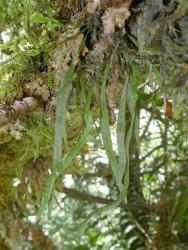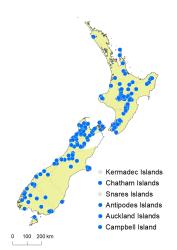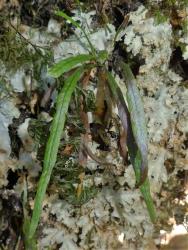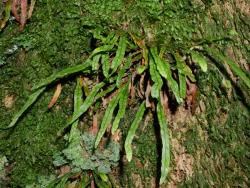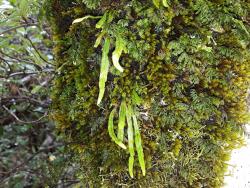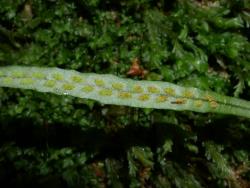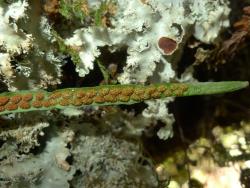- Taxon
- Gallery
- ≡ Asplenium angustifolium Jacq., Collectanea 1, 121 (1787)
- = Grammitis magellanica Desv., Mag. Neuesten Entdeck. Gesammten Naturk. Ges. Naturf. Freunde Berlin 5: 313 (1811)
- ≡ Polypodium billardierei var. magellanicum (Desv.) C.Chr., Ark. Bot. 10: 15 (1910)
- ≡ Polypodium magellanicum (Desv.) Copel., Philipp. J. Sci., C 11: 44 (1916)
- ≡ Grammitis billardierei var. magellanica (Desv.) de la Sota, Opera Lilloana 5: 205 (1961)
- = Polypodium poeppigianum Mett., Abh. Senckenberg. Naturf. Ges. 2: 37 (1857)
- ≡ Grammitis poeppigiana (Mett.) Pic.Serm., Webbia 32: 461 (1978)
- = Grammitis magellanica subsp. nothofageti Parris in Parris & Given, New Zealand J. Bot. 14: 100 (1976)
- ≡ Notogrammitis angustifolia subsp. nothofageti (Parris) Parris in Perrie & Parris, New Zealand J. Bot. 50: 466 (2012)
Rhizomes erect or rarely short-creeping, bearing scales. Rhizome scales narrowly ovate, 1.2–4.6 mm long, 0.3–0.8 mm wide, pale brown, concolorous, non-clathrate. Stipes indistinct, winged to base, glabrous or with very sparse pale red-brown hairs c. 0.1 mm long. Fronds undivided, linear to narrowly elliptic or narrowly obovate, 15–220 mm long, 2–7 mm wide; apices acute; margins entire; bases attenuate to an indistinct winged stipe; both surfaces pale green; herbaceous to coriaceous; glabrous or with sparse white to pale red-brown hairs 0.1–0.5 mm long. Hairs simple catenate, or branched with catenate branches. Hydathodes sometimes present. Sori elliptic, elongated along veins, 1.2–5.0 mm long, ± parallel to midrib or slightly oblique, in 1–37 pairs in mid to upper part of lamina, but often absent from apical portion, lacking hairs. Sporangia 180–370 µm long; spores 25–58 µm diameter.
Notogrammitis angustifolia is distinguished by its usually erect rhizome, narrow and glabrous fronds (<7 mm wide), lack of distinct stipes, absence of hairs in the sori, and sori often ± parallel to the midrib. It lacks setae and hairs with setiform branches.The number of pairs of sori is very variable, but they are often absent from the apical portion of the frond.
Aberrant forms with forked laminae are occasionally found.
North Island: Northland, Auckland, Volcanic Plateau, Gisborne, Taranaki, Southern North Island.
South Island: Western Nelson, Sounds-Nelson, Westland, Canterbury, Otago, Southland, Fiordland.
Chatham Islands, Stewart Island, Antipodes Islands, Auckland Islands, Campbell Island.
Altitudinal range: 10–1400 m.
In the North Island Notogrammitis angustifolia occurs in montane regions from Great Barrier Island to the Tararua Mountains, with an outlying population in Warawara Forest. It grows from 400 m on Mt Holdsworth in the Tararua Ranges, to 1400 m on Mt Taranaki and the Raukūmara and Kaimanawa Ranges. It is common throughout the South Island, west of the main divide, but populations on the east coast are confined to the Catlins District, around Dunedin, and on Banks Peninsula. It reaches 1000 m near Maruia Springs, but descends almost to sea level in south Westland and Fiordland. It extends also to the Chatham Islands, Stewart Island and the southern subantarctic islands.
Also Chile, Argentina, Tristan da Cunha, Gough Island, South Africa, Australia (Victoria, Tasmania) (Perrie & Parris 2012).
Notogrammitis angustifolia is found as an epiphyte in podocarp, broadleaved and beech forest, in subalpine scrub, and rarely on cliff faces and banks. It favours high rainfall areas and has been recorded growing on Dicksonia squarrosa, Archeria sp., Brachyglottis elaeagnifolia, Carpodetus serratus, Coprosma antipoda, C. dumosa, C. foetidissima, C. grandifolia, C. pseudocuneata, Dracophyllum arboreum, D. scoparium, Griselinia littoralis, Halocarpus bidwillii, H. biformis, Libocedrus bidwillii, Metrosideros umbellata, Olearia avicenniifolia, O. chathamica, O. colensoi, O. ilicifolia, Phyllocladus alpinus, Podocarpus laetus, P. totara, Prumnopitys ferruginea, Pseudowintera colorata, Quintinia serrata, Toronia toru, Weinmannia racemosa and species of Nothofagaceae, as well as in Pleurophyllum bog and Carex ternaria swamp.
There is morphological evidence for occasional hybrids between N. angustifolia and N. billardierei (CHR 178291, 189609, 214621, 387076).
No chromosome count has been made from New Zealand plants, but n = 37 has been recorded for Australian material (Parris 1998).
This species was previously known in Australasia as Grammitis magellanica Desv. (e.g. Parris 1998; Brownsey & Smith-Dodsworth 2000). The earliest basionym for the species is Asplenium angustifolium Jacq.; the combination in Grammitis is pre-occupied by G. angustifolia Hew. (1838), but is available in the new genus Notogrammitis (Perrie & Parris 2012).
Parris & Given (1976) recognised two subspecies in New Zealand: subsp. angustifolia, confined to the subantarctic, and subsp. nothofageti, confined to the main islands. Subsp. angustifolia was distinguished by its habit of growing in colonies, its lax fronds, and its often darkened vein endings, whereas subsp. nothofageti was distinguished by its solitary habit, erect or pendulous fronds, and vein endings that were not darkened. It was also said to have larger sporangia and spores than subsp. angustifolia (Parris & Given 1976). However, with the benefit of additional specimens the distinction between the two subspecies is much less clear, and they are not recognised here.



